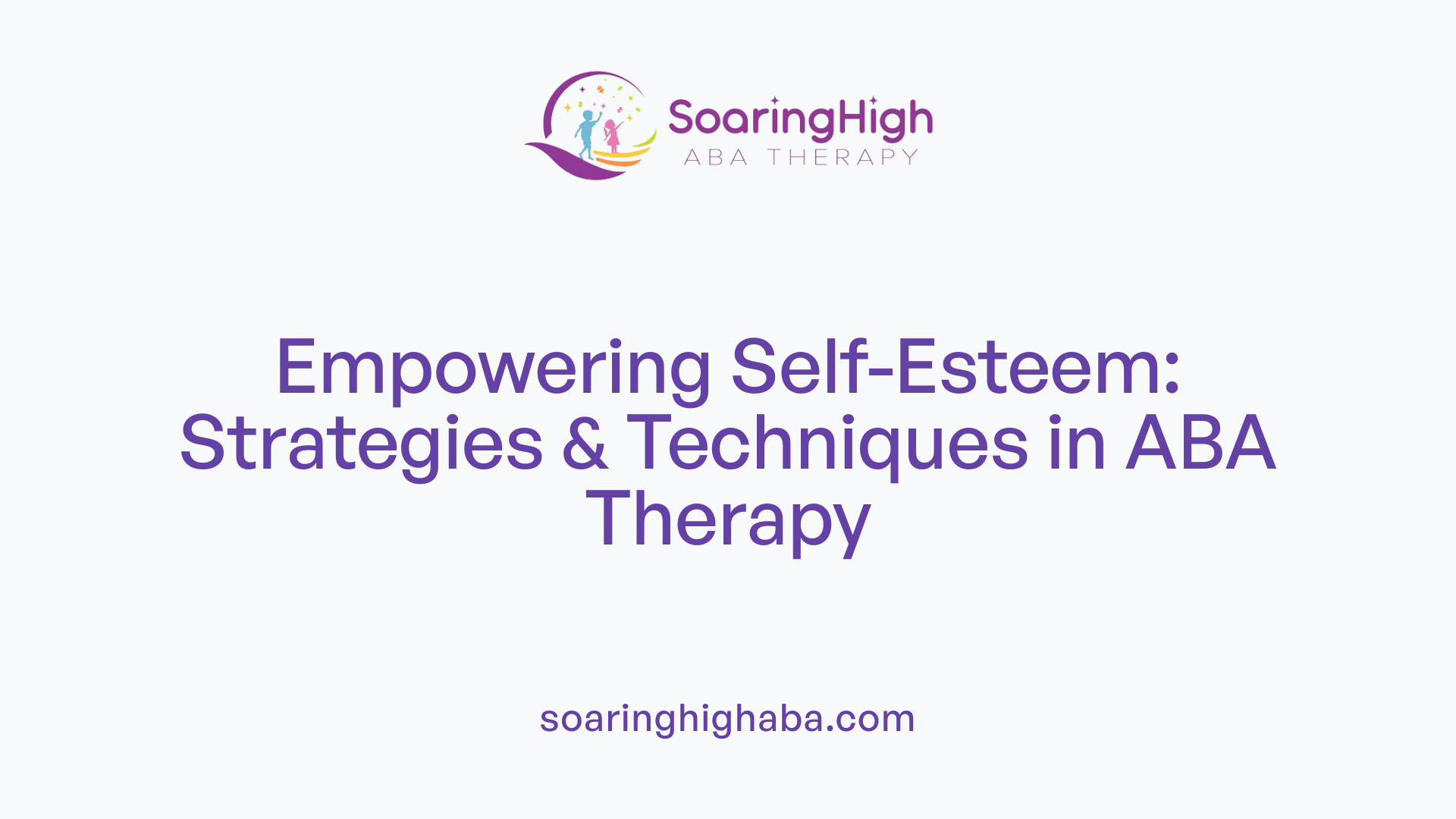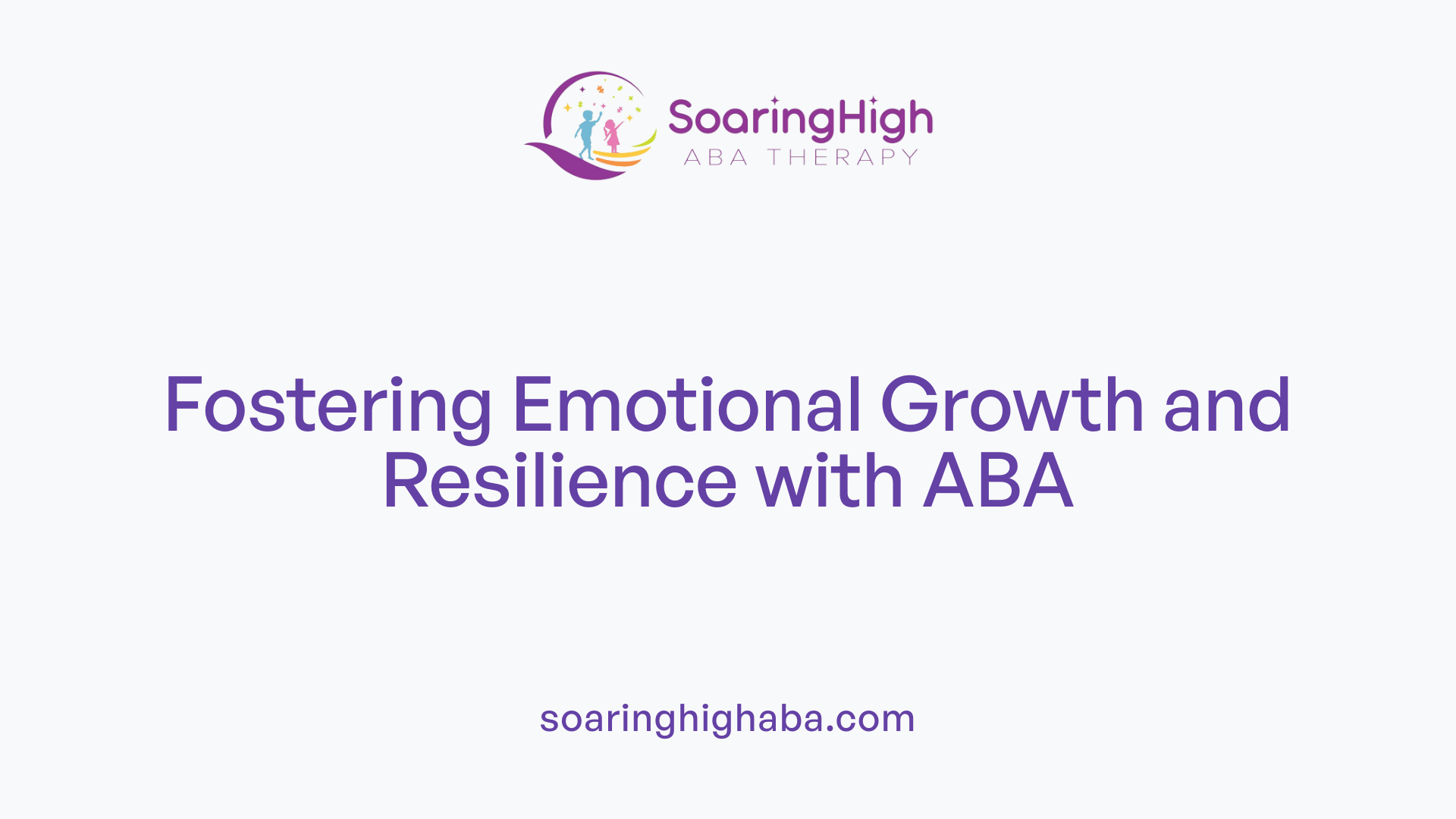Building Confidence and Self-Esteem with Structured Support
For children with autism, developing positive self-esteem and confidence is a vital step toward independence and successful integration into social and daily life. Applied Behavior Analysis (ABA) therapy emerges as a highly effective approach that leverages structured, individualized strategies to foster emotional growth, social skills, and functional independence. This article explores how ABA therapy nurtures self-worth and confidence, emphasizing its techniques, benefits, and the role of families and caregivers.
The Role of Structured Environments in Building Confidence

How does ABA therapy help promote positive self-esteem and confidence in children with autism?
Applied Behavior Analysis (ABA) therapy is a proven method to support children with autism in developing confidence and self-esteem. It works by breaking down complex social, communication, and daily living skills into manageable steps. Through consistent, structured teaching, children learn and practice these skills in a supportive environment.
One of the core techniques used in ABA is positive reinforcement. When children successfully complete tasks or exhibit desired behaviors, they receive immediate rewards such as praise, toys, or preferred activities. This immediate feedback makes children feel good about their efforts and encourages them to try again.
As children master new skills—be it communicating their needs, dressing themselves, or engaging in social activities—they develop a sense of achievement. This ongoing sense of success builds their confidence and fosters independence.
ABA therapy also addresses emotional regulation and behavioral challenges. Helping children manage their emotions reduces feelings of frustration and anxiety, creating a more positive outlook towards social interactions.
Moreover, ABA supports exploration and active participation in various settings. Children are encouraged to engage in activities that match their interests, which enhances their motivation and self-perception.
Overall, the structured approach, combined with continuous positive reinforcement and skill mastery, helps children with autism recognize their progress. Feeling capable and supported boosts their self-esteem, making them more willing to face new challenges and develop resilience.
Techniques and Strategies in ABA for Enhancing Self-Esteem

What strategies and approaches are used in ABA therapy to help improve self-esteem and emotional well-being in children with autism?
Applied Behavior Analysis (ABA) employs a variety of methods aimed at boosting self-confidence and emotional health among children with autism. One fundamental approach involves positive reinforcement and the use of rewards, such as praise, tokens, or preferred activities. These rewards motivate children to succeed in tasks and social interactions, making them feel capable and appreciated.
Structured routines and visual aids are also central to ABA. Visual schedules and social stories help children understand daily routines and expected behaviors, reducing anxiety and providing a sense of predictability. Modeling is used to demonstrate desired behaviors, allowing children to observe and imitate actions, further reinforcing learning and self-assurance.
Breaking tasks into small, manageable steps through task analysis makes activities less overwhelming. This approach enables children to achieve success in each step, gradually building their independence and confidence.
In addition, ABA incorporates strategies like self-monitoring, goal-setting, and self-reinforcement. These self-management tools foster a sense of accomplishment, empowering children to recognize their progress and develop autonomy.
Collaboration with families and educators ensures these techniques are consistently reinforced across different environments, supporting the child's emotional development and helping internalize positive behaviors. Collectively, these strategies create a nurturing environment where children can thrive emotionally, feel competent, and build resilience.
The Power of Positive Reinforcement in Building Self-Perception

How does positive reinforcement in ABA therapy influence children's self-perception and confidence?
Positive reinforcement is a cornerstone of ABA therapy and plays a vital role in shaping how children with autism see themselves and their abilities. By consistently acknowledging and rewarding desired behaviors, children learn to associate positive outcomes with their actions, fostering a sense of accomplishment and self-worth.
One of the biggest benefits of positive reinforcement is that it encourages children to continue practicing new skills. When rewards such as praise, toys, or activities are given immediately after a desired behavior, children feel recognized and valued. This immediate feedback boosts their confidence because they experience direct success and validation.
Using specific praise helps children understand exactly what they did well. For instance, saying “Great job sharing your toy!” makes it clear which behavior is appreciated. Tailored rewards, like a favorite game or extra playtime, motivate children to stay engaged and try their best.
Moreover, positive reinforcement supports the development of a growth mindset. Children learn that effort and persistence lead to positive results, which encourages resilience. They become more willing to face challenges and less likely to give up when things are difficult.
Building a supportive environment through consistent, immediate rewards also strengthens relationships between children and caregivers or teachers. This trust and connection further promote confidence, as children feel safe and understood.
Overall, positive reinforcement helps children with autism view themselves as capable and successful. It nurtures their social and emotional development, leading to greater independence, better emotional regulation, and a more positive self-image.
How can consistent and immediate reinforcement enhance learning?
Establishing a routine where rewards follow closely after desirable behaviors ensures that children associate their actions with positive outcomes. Consistency reinforces learning and promotes the internalization of new skills.
Why is tailored rewards and specific praise important?
Customization of rewards to match individual interests and specific praise helps sustain motivation and clarifies expectations, making learning more effective.
How does building resilience and a growth mindset benefit children?
Encouraging children to view challenges as opportunities to grow fosters resilience, reduces frustration, and increases confidence over time.
How do caregiver and child relationships grow through positive reinforcement?
Together, celebrating successes and providing supportive feedback strengthen bonds, create trust, and enhance the overall confidence of children with autism.
Promoting Independence and Celebrating Progress

What are the benefits of ABA therapy in enhancing self-confidence and independence among children with autism?
ABA (Applied Behavior Analysis) therapy plays a vital role in building both confidence and independence in children with autism. This approach is highly individualized, focusing on teaching essential skills in a structured and supportive environment.
One of the primary benefits of ABA is the development of communication skills. Children learn to express themselves through verbal language, gestures, or communication devices, making social interactions easier and more meaningful. When children can convey their needs and thoughts, they naturally develop a greater sense of self-assurance.
ABA also emphasizes daily living skills such as brushing teeth, dressing, and managing simple household chores. By breaking tasks into manageable steps and gradually increasing complexity, children experience a sense of achievement and mastery. As these routines become habits, children gain confidence in their ability to perform activities independently.
Reducing problematic behaviors through consistent positive reinforcement encourages children to try new things and persist despite challenges. Rewards like praise, toys, or preferred activities motivate children, boosting their motivation and self-esteem.
Furthermore, ABA strategies help children generalize learned skills across different settings—home, school, and community—so they can confidently navigate various environments.
The overall effect of ABA therapy includes improved social skills, emotional regulation, and self-management. As children meet milestones and celebrate their progress, they develop a strong sense of achievement and resilience. Their growing independence fosters a positive self-image, which is essential for long-term success and well-being.
How does creating structured routines and milestones support self-esteem?
Structured routines and clear milestones are fundamental in helping children with autism feel secure and capable. When daily activities are predictable and routines are visually mapped out, children experience less anxiety and become more willing to participate.
Celebrating milestones—such as completing a dressing routine or successfully communicating a need—reinforces effort and capability. Recognizing these achievements publicly or privately encourages children to continue striving for progress.
In addition, goal setting, whether focused on mastering a new skill or improving social interactions, involves children in their learning process. Involving them increases motivation and gives a sense of ownership over their development.
In what ways can skills learned in ABA be applied across different environments?
A crucial aspect of ABA therapy is ensuring that skills are not limited to therapy sessions but are transferred into everyday life. Visual schedules, consistent routines, and prompting techniques help children apply learned behaviors at home, school, and community settings.
For example, a child taught to manage their self-care routines at home will be more likely to perform them independently when out in public, such as during shopping or visiting friends. This consistency promotes confidence and reduces anxiety about unfamiliar situations.
In summary, ABA therapy equips children with the skills and confidence needed to become more independent. Celebrating each success along the way reinforces their efforts, enabling them to thrive across all areas of life.
Emotional and Psychological Growth Through ABA

How does ABA therapy support emotion recognition and regulation in children with autism?
ABA therapy plays a significant role in helping children with autism develop emotional understanding and control. Through the use of visual supports and social stories, children learn to recognize and interpret facial expressions, tone of voice, and body language. These tools provide clear, predictable visual cues that guide children in understanding their own feelings and those of others.
Social stories demonstrate appropriate responses to various social and emotional situations, helping children navigate complex interactions with confidence. Over time, these approaches promote better emotion regulation, allowing children to manage feelings of frustration, anxiety, or excitement constructively.
How are visual supports and social stories used to foster emotional and social skills?
Visual supports, including picture schedules and emotion cards, serve as accessible references for children to identify emotions and plan their responses. They reduce anxiety by providing predictability and clarity.
Social stories are personalized narratives that outline steps for managing specific social situations or emotional challenges. They help children understand expectations and appropriate reactions, which builds their confidence and social competence.
What methods are used to build functional communication and self-confidence?
Building communication skills involves teaching children how to express their needs and feelings through speech, gestures, or assistive devices. ABA techniques like modeling and prompting encourage children to practice these skills while reinforcing successful attempts.
Fostering functional communication empowers children to navigate daily challenges independently, leading to increased self-confidence.
Overall impact of ABA on children's emotional health and self-esteem
Consistent application of these strategies in ABA creates a supportive environment where children can experience successes and learn from their experiences. Reinforcing emotional recognition and regulation builds self-awareness and empathy.
By mastering these skills, children develop a more positive self-image, resilience, and a stronger sense of mastery over their actions and feelings. This foundation supports lifelong emotional well-being and confidence, enabling children with autism to engage more fully in social and personal pursuits.
| Strategy | Description | Benefits |
|---|---|---|
| Visual supports | Emotions charts, picture schedules | Reduce anxiety, improve understanding |
| Social stories | Personalized stories about social cues | Foster appropriate responses, build confidence |
| Functional communication | Teaching expressive language and gestures | Increase independence and self-esteem |
| Reinforcement | Reward progress and efforts | Encourage continued growth |
This structured approach ensures that children with autism develop crucial emotional and psychological skills, setting the stage for a more independent and fulfilling life.
Involving Families and Tailoring Interventions for Lasting Impact
How important is family participation in ABA strategies?
Family involvement is vital in ensuring the success of ABA therapy for children with autism. Parents and caregivers are encouraged to actively participate by learning and applying ABA techniques at home. This consistent reinforcement helps children internalize skills, builds confidence, and provides a sense of stability and support. When families are engaged, they can effectively facilitate routines, use positive reinforcement, and monitor progress, which enhances the overall impact of therapy.
What are individualized treatment plans, and why are they essential?
Each child with autism has unique strengths, challenges, and interests. Personalized ABA treatment plans are tailored to meet these specific needs. These plans set clear, achievable goals based on detailed assessments, focusing on areas like communication, social skills, independence, and emotional regulation. Customizing interventions ensures that children are motivated, experience success, and develop confidence as they master relevant skills.
How does ongoing assessment and progress monitoring contribute?
Continuous evaluation of a child's development allows therapists and families to track improvements, identify emerging needs, and adjust goals accordingly. Regular assessments help ensure that interventions remain effective and relevant. This dynamic approach keeps children motivated by celebrating incremental achievements, reinforcing positive behaviors, and addressing setbacks promptly, thereby fostering resilience and self-esteem.
How are skills generalized across environments?
For children with autism, transferring learned skills from therapy sessions to real-life situations is crucial. Strategies such as creating consistent routines, using visual schedules, and involving multiple settings (home, school, community) help children apply new skills broadly. This generalization increases independence and confidence, making children more comfortable and capable in varied social and daily scenarios.
What strategies and approaches are used in ABA therapy to help improve self-esteem and emotional well-being in children with autism?
ABA therapy uses multiple tactics to support emotional health and confidence. Key methods include positive reinforcement, which rewards desired behaviors to motivate children and foster positive feelings about their progress. Social skills training enhances interactions, helping children feel more comfortable in social settings. Developing self-management skills through tools like self-monitoring and goal-setting encourages independence.
Visual aids, structured routines, and modeling help regulate emotions and reduce anxiety. These strategies create a supportive learning environment where children feel safe to try new things and take risks, further boosting self-esteem. Collaboration with families and educators ensures these skills are consistently reinforced across all settings, promoting lasting growth and emotional resilience.
Fostering Confidence and Resilience with ABA
In summary, ABA therapy plays a pivotal role in nurturing positive self-esteem and confidence in children with autism. Through tailored interventions, consistent positive reinforcement, and active collaboration with families and educators, children are empowered to develop essential life skills, express themselves effectively, and build resilience. These psychological and emotional foundations not only improve their current quality of life but also lay the groundwork for future success and independence. As research continues to support the effectiveness of ABA, its comprehensive approach remains a cornerstone in supporting children with autism on their journey toward self-confidence and well-being.
References
- Building Confidence & Independence for Kids with Autism
- The Power of Positive Reinforcement in ABA
- How ABA Therapy Influences Positive Behavior Change
- ABA Therapy for Teens: Building Independence
- Building Self-Esteem in Kids with Autism - Childwise ABA
- How ABA Therapy Helps Children with Autism Build ...
- The Psychological Effects of ABA Therapy on Children
- Developing Effective Self-Management Skills in ABA Programs
- Building Self-Esteem Through ABA Therapy





































































































